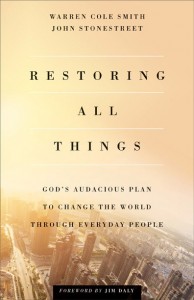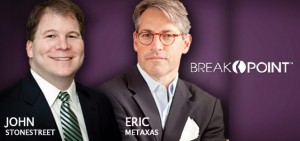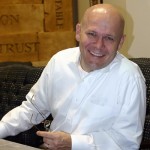One of Chuck Colson’s successors talks about God’s redemptive plan for the world
By Warren Cole Smith
(WNS)–John Stonestreet has served with best-selling author Eric Metaxas as the voice of BreakPoint, the radio ministry of the Chuck Colson Center for Christian Worldview, since the death of Chuck Colson. That program airs on more than 1,500 radio stations around the country, but my relationship with John Stonestreet is more personal. We both are speakers at Summit Ministries, a Christian worldview ministry for high school and college students in Manitou Springs, Colo. We became close friends and recently collaborated on a book called Restoring All Things: God’s Audacious Plan for Changing the World through Everyday People. I recently talked with him about that book and his work with the Colson Center.
From your point of view, what’s the book about? I just finished a book with another friend, Sean McDowell, on same-sex marriage. That’s not a topic that brings Christians, particularly conservative Christians, a lot of hope. It’s been a cultural tsunami. … I just heard so many Christians either ready to give up morally on the issue or give up as if it’s lost—that somehow a Supreme Court decision about this particular issue is the end of the kingdom of God. The truth of the whole world, always, 100 percent, is that Christ has risen from the dead. What that means is that’s the truth of everything. That’s the one truth that will not be thwarted in all of human history. … How big of a scope did the consequences and the implications of the resurrection entail? At the end of the day, that’s what it was about for me. I just wanted to be able to point people to something that was hopeful and true.
In the book, you provided the theological and philosophical underpinnings, and then I went and found stories that illustrated them. I realized when I went looking for these stories that there are thousands and thousands of them. Yet, we tend to focus on the negative too much. Do you have any idea why that is? I think the negative brings more noise and the positive seems ineffectual right now. I think the positive stories tend to get told in history, but the danger of that is that we have these larger-than-life celebrity heroes from history—and maybe a few today, but really from history—and it’s easy for us to say, “That’s Dietrich Bonhoeffer, but I’m no Bonhoeffer.”I’ve heard Eric Metaxas, who did a biography of Bonhoeffer say, if you said, “I’m no Bonhoeffer,” Bonhoeffer would say, “Who am I?” Who are you comparing yourself to? Because he didn’t see it that way either.
They are people who have done amazing things by tending the garden that God has given them in their little world of influence. If I am in Christ, I am to be reconciled and then I am to be reconciler. I’m to be one that brings redemption or restoration in my neighborhood and in my community and in my family and in my home. I’m to stop evil when I can. I am to fix brokenness when I can. I am to celebrate good things when I can. … It’s not this grandiose, change-the-world sort of thing. You and I talked in the book about the pregnancy care center movement, a remarkable movement of thousands of people, primarily Christian women in communities as big as New York City and as small as Dayton, Tenn., who have decided to reach out to people who need restoration in their lives.These women, I don’t think, would say, “I’m changing the entire culture,” but we look back 20 years, and they have. Not one by themselves, but a whole bunch of them doing the same restorative work addressing a significant cultural evil of abortion and providing a restorative act. They literally changed the culture.
At the beginning of the book, we asked four questions, and those four questions really come from you. Would you explicitly say what they are? These are questions that I came up with as I was trying to wrestle through the implications of redemption, and then Gabe Lyons at a Q Conference last year added a fourth one, so I’ve got to give him credit for the fourth one.It follows that scheme of creation for our redemption. Really, two creation questions: No. 1, what is good that we can celebrate? When God created the world, He said, “It is good.” We don’t live in a bad world. We live in a world that’s good gone bad, and there are still very good things in the world that are worth celebrating, whether it’s truth or justice or human dignity or religious liberty. These things have brought good things to the world.
 The second creation question has to do with the image of God in all of us, which is our creative ability. We’re in the image of a creative God. It’s the question, what’s missing that we can contribute? Some of the great Christian cultural influencers in the history of the world have looked and said, “Something’s missing, I’m going to throw it in.” Look at the most important invention of all time, the printing press. Gutenberg basically said, “If we came up with something, the Bible would be more widely available and that’s a good thing.”
The second creation question has to do with the image of God in all of us, which is our creative ability. We’re in the image of a creative God. It’s the question, what’s missing that we can contribute? Some of the great Christian cultural influencers in the history of the world have looked and said, “Something’s missing, I’m going to throw it in.” Look at the most important invention of all time, the printing press. Gutenberg basically said, “If we came up with something, the Bible would be more widely available and that’s a good thing.”
The third question has to do with the fall, “What’s evil that we can stop?” … What evil cannot be tolerated as long as I’m here, and I will fight it, and I will do what I can.
Then fourth one is the redemption question, which is, what is broken that needs to be restored? … If you’ll just look at the Bible at face value, it’s obvious. God loves “re-” words. There’s “re-“ words all over the place particularly anytime the gospel is talked about. … What can be fixed? What can be restored? What can be renewed? What can be put back together and reconciled again?
Those four questions, to me, give us a great little framework. Now, the next question is, where are we looking for those four things? I think that’s the other unique contribution of the book.
By that, you mean, are we looking out at the big wide world or are we looking in our own backyard? That’s exactly right. I think one of the things that’s really trapped Christian conservatives in maybe some form of a despair is that we’ve spent a whole lot of time looking at the top of culture—Washington, D.C., New York, Hollywood. “Look at all the filth that’s coming out of there,” we say, or, “Look at all the really bad ideas.” Certainly, that’s true, but culture can be shifted locally more than from the top down. We may not be able to do something about Washington, D.C., but we can do something about Lexington or we can do something about Santa Barbara or about Colorado Springs.
This is what we call in the book “the power of the middle.” We’ve got one political party telling us, “Look at the top of culture, the big government” and another political party telling us, “We need radical individual freedom.” But in between big culture or the big state and individuals are all of these other institutions that provide strength and depth and meaning and shape people’s lives.
It’s what Alexis de Tocqueville referred to as the mediating institutions or the middle institutions: Family and church and local government, voluntary associations and entrepreneurship and all these things in the middle that actually help individuals be good citizens and keep the big state at bay. I think it’s a better place for us to look and aim our redemptive and restorative activities.
I want to shift gears with you a little bit and go from talking about the book to your larger work. I think for both of us, but in particular for you because you got to actually work for the man, Chuck Colson was a powerful influence. Can you talk about Chuck and your experience with him? I was living and teaching in Dayton, Tenn., at a place called Bryan College. I was doing a lot of worldview stuff and a little bit of writing, working at Summit Ministries, of course. I reached out to a guy named T.M. Moore who had been a theological adviser to Chuck.
That started this relationship with Chuck and got me connected with the Centurions program. I remember the first time I was invited to speak in person at one of the residencies. I met Chuck and shook his hand and then I said, “Good heavens. He’s sitting in the back of my session. Why isn’t he leaving?” and he didn’t leave. … That was Chuck’s posture. He was really humble and yet really, really, really smart. And, probably, I’ve never seen that mix in an individual.
I’ve heard Eric Metaxas say, and maybe you said it this way, too, that Chuck was able to hold orthodoxy and orthopraxy together at a very high level. It seems a lot of folks in Christendom are either so theologically or doctrinally pure that no good works can penetrate them, or the other way around. They get so engaged in social justice issues that they throw doctrine and theology and Biblical standards out the window. Chuck was able to hold both of those together beautifully. He was and not just as two separate things. When I hear that phrase, “orthodoxy and orthopraxy,” sometimes it’s like he’s really smart and he’s a good person, or he’s got all these doctrinal things in line and he gives to charity and feeds the homeless. These two are really good things, but Chuck was often able to hold the two not just at the same time but hold the two together over top of each other. What I mean by that is that demands things of how we engage and interact not just with individual persons but with the culture itself. There came a time when William Wilberforce just said, you know what? Slavery structurally needs to go. There have been lots of abolitionists freeing slaves, buying them and freeing them or trying to sneak them out or whatever. Wilberforce was like, no, structurally, this has got to end.
It’s an evil that needs to be resisted and stopped and ended. I feel like a lot of people who want to hold these, orthodoxy and orthopraxy, but they don’t realize the implications of orthodoxy for orthopraxy. It’s like these are two independently settled categories that we can think about separately. You’ve got to think about them together. … You say, “I’m in this cultural moment, what does this truth demand of me?” Through BreakPoint, the radio show now that Eric Metaxas and I [host], Chuck was able to point the church to cultural issues more than anyone else of the last generation. He made the church care about culture, and I think that’s probably his best contribution.
 Under Chuck’s leadership, BreakPoint grew to be something that really can move the needle on certain cultural conversations. That’s really a unique platform in this country. It is. Sometimes we think, “Shoot, it’s a four-minute commentary.” If somebody gets behind traffic and has to drop their kid off at school four minutes later than normal, they’ve missed us because it’s not that 30-minute long format. But we have so many stations that carry it multiple times a day, and we’ve got so many people subscribed on radio and on podcast, that it can [have an impact]. One of the stories that I’m proudest of over the last several years is our work to keep the attention of the world on Pastor Saeed Abedini. The American Center for Law and Justice has been nothing less than heroic on this but we’ve been an advocate, and his wife, Nagmeh, has become a friend. I just think that’s such an important story. It’s not a political commentary. We do politics unashamedly. We don’t think we should run for politics, but we also want to be bigger than politics, get upstream as much as possible whenever cultural issues are upstream from politics.
Under Chuck’s leadership, BreakPoint grew to be something that really can move the needle on certain cultural conversations. That’s really a unique platform in this country. It is. Sometimes we think, “Shoot, it’s a four-minute commentary.” If somebody gets behind traffic and has to drop their kid off at school four minutes later than normal, they’ve missed us because it’s not that 30-minute long format. But we have so many stations that carry it multiple times a day, and we’ve got so many people subscribed on radio and on podcast, that it can [have an impact]. One of the stories that I’m proudest of over the last several years is our work to keep the attention of the world on Pastor Saeed Abedini. The American Center for Law and Justice has been nothing less than heroic on this but we’ve been an advocate, and his wife, Nagmeh, has become a friend. I just think that’s such an important story. It’s not a political commentary. We do politics unashamedly. We don’t think we should run for politics, but we also want to be bigger than politics, get upstream as much as possible whenever cultural issues are upstream from politics.
You and your wife and three daughters live Colorado Springs, Colo. What do you do for fun? I spend a lot of time on the road, and so the best thing that I do, when I’m home and when I want to relax, it involves the family. … We have three little girls. We enjoy Colorado Springs a lot. We spend a lot of time enjoying that. We’ve got three acres where we enjoy the outdoors. That’s a lot of fun. I’m a sports fan, too. I know there’s very little evidence of it today, but I played basketball at one time in my life. Whenever March rolls around, I get a lot less done than I normally do. I love March Madness. My wife is a ferocious reader and a ferocious student now of church history. It’s been fun, the last year and a half or so. Some of the most enjoyable times have been she and I just chatting through these ideas. I think it’s really been good for us not to just talk about what’s happening with the kids, what we’ve got to do tomorrow, but to really dive into interesting issues like that.
John, you’re a fairly young man, and I hope you have many more years ahead of you, but unless you’ve figured out something that I haven’t, we’re all going to die one day. Whoever is standing over your grave, what do you want them to say about you? I helped bury my grandfather about a year and a half ago, and it’s been a really significant point for me to start thinking these thoughts. … He and my grandmother were married 63 years, and he had this dairy farm full-time. When I was born was essentially when he shut the dairy farm and the dairy business down and then he went full-time supporting my grandmother’s catering business, which really did very, very well in that Northern Virginia area. He was just for his family and that was very, very clear. There’s lots of kids and grandkids and great grandkids and now even great, great grandkids in the mix—very, very diverse—and there was just this universal sense that this guy was stable. I also think about what my grandmother said when people come up and say those stupid things that people say when they try to comfort you, like, “Well, you had so many good years together.” She just said, “So what? I want more.” If my wife will say that, that’ll probably be good enough.








